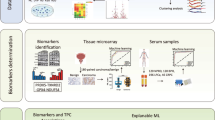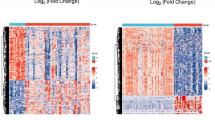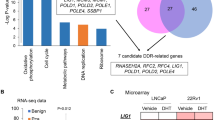Abstract
Background
Cancer-related fatigue (CRF) is a prominent cancer-related complication occurring in Prostate cancer (PCa) patients, profoundly affecting prognosis. The lack of diagnostic criteria and biomarkers hampers the management of CRF.
Methods
The CRF-related data and PCa single-cell data were retrieved from the GEO database and clinical data was downloaded from the TCGA database. The univariate logistic/Cox regression analysis were used to construct the prediction models. The predictive value of models was analyzed using the ROC curve and Kaplan-Meier survival. The hub genes were screened by an intersection analysis of DEGs. The mice model of PCa and PCa-related fatigue were established, and fatigue-like behaviors of mice were detected. The expression of selected hub genes was validated by RT-PCR and IHC analysis.
Results
The diagnosis and risk models showed great predictive value both in the training and validation dataset. Five genes (Baiap2l2, Cacng4, Sytl2, Sec31b and Ms4a1) that enriched the CXCL signaling were identified as hub genes. Among all hub genes, the MS4A1 expression is the most significant in PCa-related fatigue mice.
Conclusions
We identified MS4A1 as a promising biomarker for the diagnosis of PCa-related fatigue. Our findings would lay a foundation for revealing the pathogenesis and developing therapies for PCa-related fatigue.
This is a preview of subscription content, access via your institution
Access options
Subscribe to this journal
Receive 24 print issues and online access
269,00 € per year
only 11,21 € per issue
Buy this article
- Purchase on SpringerLink
- Instant access to full article PDF
Prices may be subject to local taxes which are calculated during checkout






Similar content being viewed by others
Data availability
The data generated in the present study may be found in the Gene Expression Omnibus database (https://www.ncbi.nlm.nih.gov/geo) under accession number GSE30174, GSE14786, GSE84437, and GSE143791. We sourced the gene expression matrix and associated clinical data for PCa from the TCGA database (https://portal.gdc.cancer.gov/). The single cell sequencing data and results were acquired from the TISCH2 public data platform (http://tisch.comp-genomics.org/).
Code availability
The relevant R codes utilised in this study can be accessed through the following GitHub repositories: https://github.com/cherishCM/CRF-code.git.
References
James ND, Tannock I, N’Dow J, Feng F, Gillessen S, Ali SA, et al. The Lancet Commission on prostate cancer: planning for the surge in cases. Lancet. 2024;403:1683–722.
Cheng KK, Lee DT. Effects of pain, fatigue, insomnia, and mood disturbance on functional status and quality of life of elderly patients with cancer. Crit Rev Oncol Hematol. 2011;78:127–37.
Thong MSY, van Noorden CJF, Steindorf K, Arndt V. Cancer-related fatigue: causes and current treatment options. Curr Treat Options Oncol. 2020;21:17.
Baguley BJ, Bolam KA, Wright ORL, Skinner TL. The effect of nutrition therapy and exercise on cancer-related fatigue and quality of life in men with prostate cancer: a systematic review. Nutrients. 2017;8:623–9.
Nazha B, Bilen MA. Circulating interleukin 6, androgen deprivation therapy, and fatigue in prostate cancer: Is inflammation the link? Cancer. 2021;127:1371–3.
Gavin AT, Drummond FJ, Donnelly C, O’Leary E, Sharp L, Kinnear HR. Patient-reported ‘ever had’ and ‘current’ long-term physical symptoms after prostate cancer treatments. BJU Int. 2015;116:397–406.
Yang S, Chu S, Gao Y, Ai Q, Liu Y, Li X, et al. A Narrative Review of Cancer-Related Fatigue (CRF) and Its Possible Pathogenesis. Cells. 2019;8:738.
Zhang Y, Huang X, Feng S, Chen C, Guo D, Fang L. Platinum accumulation and cancer-related fatigue, correlation with IL-8, TNF-alpha and Hemocytes. Front Pharm. 2021;12:658792.
Bower JE, Ganz PA, Irwin MR, Crespi CM, Petersen L, Asher A, et al. Type I interferons, inflammation, and fatigue in a longitudinal RNA study of women with breast cancer. Brain Behav Immun. 2024;118:312–7.
Kaushik D, Shah PK, Mukherjee N, Ji N, Dursun F, Kumar AP, et al. Effects of yoga in men with prostate cancer on quality of life and immune response: a pilot randomized controlled trial. Prostate Cancer Prostatic Dis. 2022;25:531–8.
Saligan LN, Hsiao CP, Wang D, Wang XM, St John L, Kaushal A, et al. Upregulation of α-synuclein during localized radiation therapy signals the association of cancer-related fatigue with the activation of inflammatory and neuroprotective pathways. Brain Behav Immun. 2013;27:63–70.
Landmark-Høyvik H, Reinertsen KV, Loge JH, Fosså SD, Børresen-Dale AL, Dumeaux V. Alterations of gene expression in blood cells associated with chronic fatigue in breast cancer survivors. Pharmacogenomics J. 2009;9:333–40.
Yoon SJ, Park J, Shin Y, Choi Y, Park SW, Kang SG, et al. Deconvolution of diffuse gastric cancer and the suppression of CD34 on the BALB/c nude mice model. BMC Cancer. 2020;20:314.
Kfoury Y, Baryawno N, Severe N, Mei S, Gustafsson K, Hirz T, et al. Human prostate cancer bone metastases have an actionable immunosuppressive microenvironment. Cancer Cell. 2021;39:1464–1478.e1468.
Colaprico A, Silva TC, Olsen C, Garofano L, Cava C, Garolini D, et al. TCGAbiolinks: an R/Bioconductor package for integrative analysis of TCGA data. Nucleic Acids Res. 2016;44:e71.
Mariathasan S, Turley SJ, Nickles D, Castiglioni A, Yuen K, Wang Y, et al. TGFβ attenuates tumour response to PD-L1 blockade by contributing to exclusion of T cells. Nature. 2018;554:544–8.
Shannon P, Markiel A, Ozier O, Baliga NS, Wang JT, Ramage D, et al. Cytoscape: a software environment for integrated models of biomolecular interaction networks. Genome Res. 2003;13:2498–504.
Newman AM, Liu CL, Green MR, Gentles AJ, Feng W, Xu Y, et al. Robust enumeration of cell subsets from tissue expression profiles. Nat Methods. 2015;12:453–7.
Xu F, Zhan X, Zheng X, Xu H, Li Y, Huang X, et al. A signature of immune-related gene pairs predicts oncologic outcomes and response to immunotherapy in lung adenocarcinoma. Genomics. 2020;112:4675–83.
Yang W, Soares J, Greninger P, Edelman EJ, Lightfoot H, Forbes S, et al. Genomics of Drug Sensitivity in Cancer (GDSC): a resource for therapeutic biomarker discovery in cancer cells. Nucleic Acids Res. 2013;41:D955–961.
Cheng J, Yang L, Kumar V, Agarwal P. Systematic evaluation of connectivity map for disease indications. Genome Med. 2014;6:540.
Han Y, Wang Y, Dong X, Sun D, Liu Z, Yue J, et al. TISCH2: expanded datasets and new tools for single-cell transcriptome analyses of the tumor microenvironment. Nucleic Acids Res. 2023;51:D1425–d1431.
Sun D, Wang J, Han Y, Dong X, Ge J, Zheng R, et al. TISCH: a comprehensive web resource enabling interactive single-cell transcriptome visualization of tumor microenvironment. Nucleic Acids Res. 2021;49:D1420–d1430.
Abulizi A, Hu L, Ma A, Shao FY, Zhu HZ, Lin SM, et al. Ganoderic acid alleviates chemotherapy-induced fatigue in mice bearing colon tumor. Acta Pharm Sin. 2021;42:1703–13.
Grossberg AJ, Vichaya EG, Christian DL, Molkentine JM, Vermeer DW, Gross PS, et al. Tumor-Associated Fatigue in Cancer Patients Develops Independently of IL1 Signaling. Cancer Res. 2018;78:695–705.
Chelette B, Chidomere CL, Dantzer R. The GDF15-GFRAL axis mediates chemotherapy-induced fatigue in mice. Brain Behav Immun. 2023;108:45–54.
Yang F, Zhou L, Song J, WangJinMei A, Yang Y, Tang ZW, et al. Liver CEBPbeta Modulates the Kynurenine Metabolism and Mediates the Motility for Hypoxia-Induced Central Fatigue in Mice. Front Physiol. 2019;10:243.
Zhang X, Jing S, Lin H, Sun W, Jiang W, Yu C, et al. Anti-fatigue effect of anwulignan via the NRF2 and PGC-1alpha signaling pathway in mice. Food Funct. 2019;10:7755–66.
NCCN, Clinical Practice Guidelines in Oncology. Cancer-Related Fatigue Version 1 2021. (https://www.nccn.org/professionals/physician_gls/pdf/fatigue.pdf.) (2020).
Arring NM, Barton DL, Brooks T, Zick SM. Integrative therapies for cancer-related fatigue. Cancer J. 2019;25:349–56.
David A, Hausner D, Frenkel M. Cancer-related fatigue-is there a role for complementary and integrative medicine? Curr Oncol Rep. 2021;23:145.
Bower JE. The role of neuro-immune interactions in cancer-related fatigue: Biobehavioral risk factors and mechanisms. Cancer. 2019;125:353–64.
Heidegger I, Fotakis G, Offermann A, Goveia J, Daum S, Salcher S, et al. Comprehensive characterization of the prostate tumor microenvironment identifies CXCR4/CXCL12 crosstalk as a novel antiangiogenic therapeutic target in prostate cancer. Mol Cancer. 2022;21:132.
Lopes F, Vicentini FA, Cluny NL, Mathews AJ, Lee BH, Almishri WA, et al. Brain TNF drives post-inflammation depression-like behavior and persistent pain in experimental arthritis. Brain Behav Immun. 2020;89:224–32.
Guo H, Peng J, Hu J, Chang S, Liu H, Luo H, et al. BAIAP2L2 promotes the proliferation, migration and invasion of osteosarcoma associated with the Wnt/beta-catenin pathway. J Bone Oncol. 2021;31:100393.
Song Y, Zhuang G, Li J, Zhang M. BAIAP2L2 facilitates the malignancy of prostate cancer (PCa) via VEGF and apoptosis signaling pathways. Genes Genomics. 2021;43:421–32.
Kanwar N, Carmine-Simmen K, Nair R, Wang C, Moghadas-Jafari S, Blaser H, et al. Amplification of a calcium channel subunit CACNG4 increases breast cancer metastasis. EBioMedicine. 2020;52:102646.
Li Z, Tao Y, Gao Z, Peng S, Lai Y, Li K, et al. SYTL2 promotes metastasis of prostate cancer cells by enhancing FSCN1-mediated pseudopodia formation and invasion. J Transl Med. 2023;21:303.
Stankewich MC, Stabach PR, Morrow JS. Human Sec31B: a family of new mammalian orthologues of yeast Sec31p that associate with the COPII coat. J Cell Sci. 2006;119:958–69.
Mattiola I, Mantovani A, Locati M. The tetraspan MS4A family in homeostasis, immunity, and disease. Trends Immunol. 2021;42:764–81.
Pavlasova G, Mraz M. The regulation and function of CD20: an “enigma” of B-cell biology and targeted therapy. Haematologica. 2020;105:1494–506.
Pavlasova G, Borsky M, Svobodova V, Oppelt J, Cerna K, Novotna J, et al. Rituximab primarily targets an intra-clonal BCR signaling proficient CLL subpopulation characterized by high CD20 levels. Leukemia. 2018;32:2028–31.
Hsiao CP, Reddy SY, Chen MK, Saligan LN. Genomic profile of fatigued men receiving localized radiation therapy. Biol Res Nurs. 2016;18:281–9.
Acknowledgements
We acknowledge the GEO and TCGA database for providing datasets used in this study. We also thank the help of the Medical Research Center for structural biology and Prof. Yaping Fu for assistance with animal behavior experiments.
Funding
This work was supported by the by the National Natural Science Foundation of China (82304550 and 82401028).
Author information
Authors and Affiliations
Contributions
All authors read and approved the final version of the manuscript. M. Chen.: conceptualization, methodology, formal analysis, supervision and writing- original draft; Sq. Z.: formal analysis, validation, data curation, investigation and writing- original draft; Xw He: visualization, formal analysis and methodology; Hy. W.: conceptualization, investigation, validation, methodology and writing-review & editing.
Corresponding author
Ethics declarations
Ethics Approval And Consent To Participate
All animal procedures were performed according to the Guidelines for the Care and Use of Laboratory Animals of the Chinese Animal Welfare Committee and approved by the Institutional Animal Care and Use Committee (IACUC) of Wuhan University of Renmin Hospital.
Competing interests
The authors declare no competing interests.
Additional information
Publisher’s note Springer Nature remains neutral with regard to jurisdictional claims in published maps and institutional affiliations.
Supplementary information
Rights and permissions
Springer Nature or its licensor (e.g. a society or other partner) holds exclusive rights to this article under a publishing agreement with the author(s) or other rightsholder(s); author self-archiving of the accepted manuscript version of this article is solely governed by the terms of such publishing agreement and applicable law.
About this article
Cite this article
Chen, M., Zhou, S., He, X. et al. Identification of diagnostic biomarkers in prostate cancer-related fatigue by construction of predictive models and experimental validation. Br J Cancer 132, 283–294 (2025). https://doi.org/10.1038/s41416-024-02922-1
Received:
Revised:
Accepted:
Published:
Issue Date:
DOI: https://doi.org/10.1038/s41416-024-02922-1



